
List of Polish monarchs
Encyclopedia
Poland
, or at least its nucleus, was ruled at various times either by dukes (the 10th-14th century) or by kings (the 11th-18th century). The longest-reigning dynasties were the Piast
s (ca. 960 – 1370) and Jagiellon
s (1386–1572). Intervening and subsequent monarchs were often rulers of foreign countries or princes recruited from foreign dynasties.
During the latter period a tradition of free election of monarchs made it a uniquely electable position in Europe (16th-18th centuries). Polish independence ended with the Third Partition
of the Polish-Lithuanian Commonwealth
(1795) and was restored at the end of World War I
(1918) on a republic
an basis.
Jagiellon Dynasty
Kings of the Polish-Lithuanian Commonwealth
Tsar
Kings and Queens of Galicia and Lodomeria
Dukes of Warsaw
Poland
Poland , officially the Republic of Poland , is a country in Central Europe bordered by Germany to the west; the Czech Republic and Slovakia to the south; Ukraine, Belarus and Lithuania to the east; and the Baltic Sea and Kaliningrad Oblast, a Russian exclave, to the north...
, or at least its nucleus, was ruled at various times either by dukes (the 10th-14th century) or by kings (the 11th-18th century). The longest-reigning dynasties were the Piast
Piast dynasty
The Piast dynasty was the first historical ruling dynasty of Poland. It began with the semi-legendary Piast Kołodziej . The first historical ruler was Duke Mieszko I . The Piasts' royal rule in Poland ended in 1370 with the death of king Casimir the Great...
s (ca. 960 – 1370) and Jagiellon
Jagiellon dynasty
The Jagiellonian dynasty was a royal dynasty originating from the Lithuanian House of Gediminas dynasty that reigned in Central European countries between the 14th and 16th century...
s (1386–1572). Intervening and subsequent monarchs were often rulers of foreign countries or princes recruited from foreign dynasties.
During the latter period a tradition of free election of monarchs made it a uniquely electable position in Europe (16th-18th centuries). Polish independence ended with the Third Partition
Third Partition of Poland
The Third Partition of Poland or Third Partition of the Polish-Lithuanian Commonwealth took place in 1795 as the third and last of three partitions that ended the existence of the Polish-Lithuanian Commonwealth.-Background:...
of the Polish-Lithuanian Commonwealth
Polish-Lithuanian Commonwealth
The Polish–Lithuanian Commonwealth was a dualistic state of Poland and Lithuania ruled by a common monarch. It was the largest and one of the most populous countries of 16th- and 17th‑century Europe with some and a multi-ethnic population of 11 million at its peak in the early 17th century...
(1795) and was restored at the end of World War I
World War I
World War I , which was predominantly called the World War or the Great War from its occurrence until 1939, and the First World War or World War I thereafter, was a major war centred in Europe that began on 28 July 1914 and lasted until 11 November 1918...
(1918) on a republic
Republic
A republic is a form of government in which the people, or some significant portion of them, have supreme control over the government and where offices of state are elected or chosen by elected people. In modern times, a common simplified definition of a republic is a government where the head of...
an basis.
Legendary rulers
| Ruler | Tribe | Reign | Notes | |
|---|---|---|---|---|
| Lech Lech, Czech and Rus Lech, Čech, and Rus is a legend of three brothers – Lech, Čech, and Rus – who founded three Slavic nations: Poland , Bohemia, and Ruthenia... |
 |
Lechites Lechites Lechites – an ethnic and linguistic group of West Slavs, the ancestors of modern Poles and the historical Pomeranians and Polabians.-History:... |
6th century | a legendary founder of the Polish nation |
| Krakus Krakus Krakus, Krak or Grakch was a legendary Polish prince and founder of Kraków, the ruler of the tribe of Lechitians . Krakus is also credited with building Wawel Castle. The first recorded mention of Krakus, then spelled Grakch, is in the Chronica seu originale regum et principum Poloniae from 1190... |
 |
Lechites | 8th century | a legendary founder of Cracow |
| Wanda Princess Wanda Princess Wanda was the legendary daughter of Krakus, legendary founder of Kraków. Upon her father's death, she became queen of the Poles, but committed suicide to avoid an unwanted marriage.... |
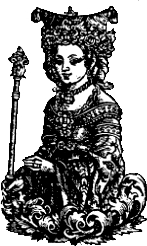 |
Lechites | 8th century | a legendary daughter of Krakus and unknown Vandal Vandals The Vandals were an East Germanic tribe that entered the late Roman Empire during the 5th century. The Vandals under king Genseric entered Africa in 429 and by 439 established a kingdom which included the Roman Africa province, besides the islands of Sicily, Corsica, Sardinia and the Balearics.... woman |
| Abraham Prochownik Abraham Prochownik Abraham Prochownik was a Jew said, in some legendary sources, to have been nominated prince of Poland, in 842 CE. After the death of Prince Popiel, the Poles allegedly held a council at Kruszwica, to elect a successor. According to the legend they disagreed for a long time, and finally decided that... |
Khazars Khazars The Khazars were semi-nomadic Turkic people who established one of the largest polities of medieval Eurasia, with the capital of Atil and territory comprising much of modern-day European Russia, western Kazakhstan, eastern Ukraine, Azerbaijan, large portions of the northern Caucasus , parts of... |
9th century | a legendary Jew, nominated prince of Polans, after the death of prince Popiel Popiel Prince Popiel was a legendary 9th century ruler of the West Slavic tribe of Goplans and Polans, the last member of the pre-Piast dynasty, the Popielids... in 842 |
|
Semi-legendary rulers of western Polans (Greater Poland)
| Ruler | Dynasty | Reign | Notes | |
|---|---|---|---|---|
| Popiel Popiel Prince Popiel was a legendary 9th century ruler of the West Slavic tribe of Goplans and Polans, the last member of the pre-Piast dynasty, the Popielids... |
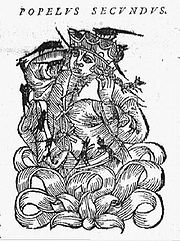 |
Popielids Popielids Popielids was a legendary ruling dynasty of either the Polans, Goplans or both tribes. They were to rule the lands of Poland prior to the start of the Piast dynasty.... |
Duke the 9th century | a semi-legendary ruler of the West Slavic ("proto-Polish") tribe of Goplans Goplans Goplans, Goplanes or Goplanie is a name of an early medieval West Slavic tribe, later to become part of the Polish nation. They were mentioned by Bavarian Geographer as 'Glopeani' and believed to have lived around Lake Gopło, with its capital in Kruszwica, between 7th-9th century AD.Medieval... and Polans Polans (western) The Polans were a West Slavic tribe, part of the Lechitic group, inhabiting the Warta river basin of the historic Greater Poland region in the 8th century.During the reign of King Svatopluk I of Great Moravia , who subdued the tribes of the Vistulans and Ślężanie... |
| Siemowit Siemowit Siemowit was, according to the chronicles of Gallus Anonymus, the son of Piast the Wheelwright and Rzepicha. He was considered one of the four legendary Piast princes, but is now considered as a ruler who existed as a historical person.... |
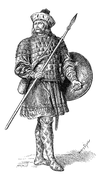 |
Piast Piast dynasty The Piast dynasty was the first historical ruling dynasty of Poland. It began with the semi-legendary Piast Kołodziej . The first historical ruler was Duke Mieszko I . The Piasts' royal rule in Poland ended in 1370 with the death of king Casimir the Great... |
Duke the 9th century | semi-legendary son of Piast the Wheelwright Piast the Wheelwright Piast Kołodziej was a semi-legendary figure in prehistoric Poland , the founder of the Piast dynasty that would rule the future Kingdom of Poland.- Legend and aftermath :... |
| Lestek Lestko Lestko is the second legendary duke of Poland, and son of Siemowit, born ca. 870-880. Though proof of his actual existence is unclear, if he did exist, he must have been an influential person, because the tribes that lived in what is now Poland were known as "Lestkowici".- Bibliography :*... |
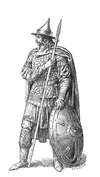 |
Piast Piast dynasty The Piast dynasty was the first historical ruling dynasty of Poland. It began with the semi-legendary Piast Kołodziej . The first historical ruler was Duke Mieszko I . The Piasts' royal rule in Poland ended in 1370 with the death of king Casimir the Great... |
Duke the 9th-10th century | semi-legendary son of Siemowit |
| Siemomysł | Piast Piast dynasty The Piast dynasty was the first historical ruling dynasty of Poland. It began with the semi-legendary Piast Kołodziej . The first historical ruler was Duke Mieszko I . The Piasts' royal rule in Poland ended in 1370 with the death of king Casimir the Great... |
Duke the 10th century | semi-legendary son of Lestko |
|
Monarchs of Poland
| Ruler | Dynasty | Reign | Notes | |
|---|---|---|---|---|
| Mieszko I of Poland Mieszko I of Poland Mieszko I , was a Duke of the Polans from about 960 until his death. A member of the Piast dynasty, he was son of Siemomysł; grandchild of Lestek; father of Bolesław I the Brave, the first crowned King of Poland; likely father of Świętosława , a Nordic Queen; and grandfather of her son, Cnut the... |
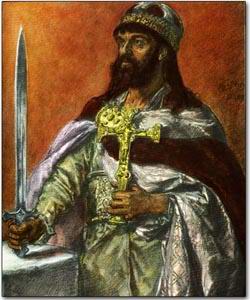 |
Piast Piast dynasty The Piast dynasty was the first historical ruling dynasty of Poland. It began with the semi-legendary Piast Kołodziej . The first historical ruler was Duke Mieszko I . The Piasts' royal rule in Poland ended in 1370 with the death of king Casimir the Great... |
Duke 960?–992 | son of Siemomysł first Christian monarch Misico, dux Wandalorum |
| Boleslas I the Brave (Bolesław I Chrobry) | 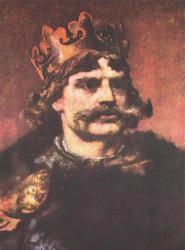 |
Piast Piast dynasty The Piast dynasty was the first historical ruling dynasty of Poland. It began with the semi-legendary Piast Kołodziej . The first historical ruler was Duke Mieszko I . The Piasts' royal rule in Poland ended in 1370 with the death of king Casimir the Great... |
Duke 992–1025 King 1025 |
son of Mieszko I and Dobrawa of Bohemia first to be crowned King Regnum Sclavorum, Gothorum sive Polonorum |
| Mieszko II Lambert Mieszko II Lambert Mieszko II Lambert was King of Poland during 1025–1031, and Duke from 1032 until his death.He was the second son of Bolesław I the Brave, but the eldest born from his third wife Emmilda, daughter of Dobromir, possible ruler of Lusatia. He was probably named after his paternal grandfather, Mieszko I... |
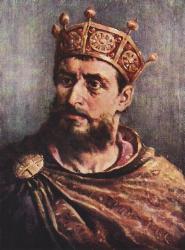 |
Piast Piast dynasty The Piast dynasty was the first historical ruling dynasty of Poland. It began with the semi-legendary Piast Kołodziej . The first historical ruler was Duke Mieszko I . The Piasts' royal rule in Poland ended in 1370 with the death of king Casimir the Great... |
King 1025–1031 | son of Boleslas I and Emnilda of Lusatia Emnilda of Lusatia Emnilda of Lusatia , was a Slavic princess and by marriage Duchess of Poland. She was a daughter of certain Dobromir, a Slavic leader ruler of Lusatia and Milsko, who was named venerable by Thietmar of Merseburg.- Life :... |
| Bezprym Bezprym Bezprym was a Duke of Poland during 1031–1032.He was the eldest son of Bolesław I the Brave, King of Poland, but was deprived of the succession by his father, who around 1001 sent him to Italy, in order to became a monk at one of Saint Romuald's hermitages in Ravenna.Expelled by his half-brother... |
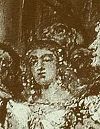 |
Piast Piast dynasty The Piast dynasty was the first historical ruling dynasty of Poland. It began with the semi-legendary Piast Kołodziej . The first historical ruler was Duke Mieszko I . The Piasts' royal rule in Poland ended in 1370 with the death of king Casimir the Great... |
Duke 1031–1032 | son of Boleslas I and Judith of Hungary Judith of Hungary Judith of Hungary was a Hungarian princess member of the House of Arpad and by marriage member of the House of Piast, who ruled Poland at that time.... (disputed) |
| Otto Bolesławowic Otto Bolesławowic Otto Bolesławowic was a Polish prince member of the House of Piast.He was the third son of Bolesław I the Brave but the second born from his third marriage with Emnilda, daughter of Dobromir, a Slavic prince of Lusatia.-Life:... |
Piast Piast dynasty The Piast dynasty was the first historical ruling dynasty of Poland. It began with the semi-legendary Piast Kołodziej . The first historical ruler was Duke Mieszko I . The Piasts' royal rule in Poland ended in 1370 with the death of king Casimir the Great... |
Duke 1032 | son of Boleslas I and Emnilda | |
| Dytryk (Thiedric) |
Piast Piast dynasty The Piast dynasty was the first historical ruling dynasty of Poland. It began with the semi-legendary Piast Kołodziej . The first historical ruler was Duke Mieszko I . The Piasts' royal rule in Poland ended in 1370 with the death of king Casimir the Great... |
Duke 1032 | grandson of Mieszko I and Oda of Haldensleben | |
| Mieszko II Lambert Mieszko II Lambert Mieszko II Lambert was King of Poland during 1025–1031, and Duke from 1032 until his death.He was the second son of Bolesław I the Brave, but the eldest born from his third wife Emmilda, daughter of Dobromir, possible ruler of Lusatia. He was probably named after his paternal grandfather, Mieszko I... |
 |
Piast Piast dynasty The Piast dynasty was the first historical ruling dynasty of Poland. It began with the semi-legendary Piast Kołodziej . The first historical ruler was Duke Mieszko I . The Piasts' royal rule in Poland ended in 1370 with the death of king Casimir the Great... |
Duke 1032–1034 | restored |
| Bolesław the Forgotten Bolesław the Forgotten Bolesław the Forgotten also Cruel , was a semi-legendary Duke of Poland of the Piast dynasty from 1034 until his death in 1038 or 1039.... (Bolesław Zapomniany) |
Piast Piast dynasty The Piast dynasty was the first historical ruling dynasty of Poland. It began with the semi-legendary Piast Kołodziej . The first historical ruler was Duke Mieszko I . The Piasts' royal rule in Poland ended in 1370 with the death of king Casimir the Great... |
Duke 1034-1039 | son of Mieszko II and Richeza of Lotharingia | |
| Casimir I the Restorer Casimir I of Poland Casimir I the Restorer , was a Duke of Poland of the Piast dynasty and the de facto monarch of the entire country from 1034 until his death.... (Kazimierz I Odnowiciel) |
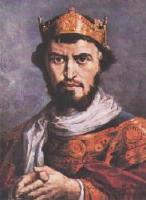 |
Piast Piast dynasty The Piast dynasty was the first historical ruling dynasty of Poland. It began with the semi-legendary Piast Kołodziej . The first historical ruler was Duke Mieszko I . The Piasts' royal rule in Poland ended in 1370 with the death of king Casimir the Great... |
Duke 1039–1058 | son of Mieszko II and Richeza of Lotharingia |
| Boleslas II the Bold (Bolesław II Szczodry) |
Piast Piast dynasty The Piast dynasty was the first historical ruling dynasty of Poland. It began with the semi-legendary Piast Kołodziej . The first historical ruler was Duke Mieszko I . The Piasts' royal rule in Poland ended in 1370 with the death of king Casimir the Great... |
Duke 1058–1076 King 1076–1079 |
son of Casimir I and Maria Dobroniega of Kiev Maria Dobroniega of Kiev Maria Dobroniega of Kiev , was a Kievian Rus princess of the Rurikid dynasty and by marriage Duchess of Poland.-Family:She was one of the youngest children of Vladimir I, Grand Prince of Kiev... |
|
| Ladislas I Herman (Władysław I Herman) |
Piast Piast dynasty The Piast dynasty was the first historical ruling dynasty of Poland. It began with the semi-legendary Piast Kołodziej . The first historical ruler was Duke Mieszko I . The Piasts' royal rule in Poland ended in 1370 with the death of king Casimir the Great... |
Duke 1079–1102 | son of Casimir I and Maria Dobroniega | |
| Vratislaus II of Bohemia Vratislaus II of Bohemia -Literature:*Vratislav Vaníček: Vratislav II. . První český král. Vyšehrad 2004, ISBN 80-7021-655-7*Hans Patze: Die Pegauer Annalen, die Königserhebung Wratislaws v. Böhmen und die Anfänge der Stadt Pegau. JGMODtl 12, 1963, 1-62... (Wratysław II Czeski) (disputed) |
Přemyslid | King of Bohemia and Poland 1085–1092 | the royal title was a grant from Henry IV, Holy Roman Emperor Henry IV, Holy Roman Emperor Henry IV was King of the Romans from 1056 and Holy Roman Emperor from 1084 until his forced abdication in 1105. He was the third emperor of the Salian dynasty and one of the most powerful and important figures of the 11th century... |
|
| Zbigniew Zbigniew of Poland Zbigniew , Duke of Poland from 1102 until 1107.-Early years:Zbigniew was the first-born son of Prince Władysław I Herman and Przecława, who apparently belonged to the Prawdzic clan... |
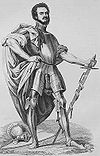 |
Piast Piast dynasty The Piast dynasty was the first historical ruling dynasty of Poland. It began with the semi-legendary Piast Kołodziej . The first historical ruler was Duke Mieszko I . The Piasts' royal rule in Poland ended in 1370 with the death of king Casimir the Great... |
Duke 1098–1107 | son of Ladislas I and Przecława, Prawdzic coat of arms Prawdzic coat of arms Prawdzic - is a Polish Coat of Arms. It was used by the nobility clans and later szlachta families in the times of the Kingdom of Poland and Polish-Lithuanian Commonwealth.-History:-Notable bearers:... (disputed) first jointly with Ladislas I 1098-1102 |
| Boleslas III Wrymouth (Bolesław III Krzywousty) |
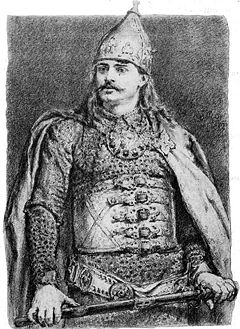 |
Piast Piast dynasty The Piast dynasty was the first historical ruling dynasty of Poland. It began with the semi-legendary Piast Kołodziej . The first historical ruler was Duke Mieszko I . The Piasts' royal rule in Poland ended in 1370 with the death of king Casimir the Great... |
Duke 1107–1138 | son of Ladislas I and Judith of Bohemia first jointly with Ladislas 1098-1102 introduced senioral principle |
| Ladislas II the Exile (Władysław II Wygnaniec) |
Piast Piast dynasty The Piast dynasty was the first historical ruling dynasty of Poland. It began with the semi-legendary Piast Kołodziej . The first historical ruler was Duke Mieszko I . The Piasts' royal rule in Poland ended in 1370 with the death of king Casimir the Great... |
High Duke 1138–1146 | son of Boleslas III and Zbyslava of Kiev Zbyslava of Kiev Zbyslava of Kiev , was a Kievan Rus' princess member of the Rurikid dynasty and by marriage Duchess of Poland.She was the daughter of Sviatopolk II, Grand Prince of Kiev by his first wife, who is believed was a Premyslid princess.-Life:... also Duke of Silesia exiled by his brothers |
|
| Boleslas IV the Curly (Bolesław IV Kędzierzawy) |
Piast Piast dynasty The Piast dynasty was the first historical ruling dynasty of Poland. It began with the semi-legendary Piast Kołodziej . The first historical ruler was Duke Mieszko I . The Piasts' royal rule in Poland ended in 1370 with the death of king Casimir the Great... |
High Duke 1146–1173 | son of Boleslas III and Salomea of Berg Salomea of Berg Salomea of Berg was a German noblewoman and by marriage Duchess of Poland.She was the daughter of Swabian Count Henry of Berg Castle by his wife Adelaide of Mochental , probably a sister of Margrave Diepold III of Vohburg... also Duke of Masovia |
|
| Mieszko III the Old Mieszko III the Old Mieszko III the Old , of the royal Piast dynasty, was Duke of Greater Poland from 1138 and High Duke of Poland, with interruptions, from 1173 until his death.... (Mieszko III Stary) |
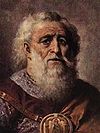 |
Piast Piast dynasty The Piast dynasty was the first historical ruling dynasty of Poland. It began with the semi-legendary Piast Kołodziej . The first historical ruler was Duke Mieszko I . The Piasts' royal rule in Poland ended in 1370 with the death of king Casimir the Great... |
High Duke 1173–1177 | son of Boleslas III and Salomea also Duke of Greater Poland |
| Casimir II the Just (Kazimierz II Sprawiedliwy) |
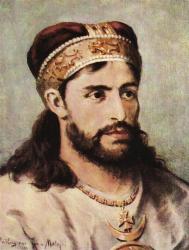 |
Piast Piast dynasty The Piast dynasty was the first historical ruling dynasty of Poland. It began with the semi-legendary Piast Kołodziej . The first historical ruler was Duke Mieszko I . The Piasts' royal rule in Poland ended in 1370 with the death of king Casimir the Great... |
High Duke 1177–1190 | son of Boleslas III and Salomea also Duke of Wiślica and Sandomierz |
| Mieszko III the Old Mieszko III the Old Mieszko III the Old , of the royal Piast dynasty, was Duke of Greater Poland from 1138 and High Duke of Poland, with interruptions, from 1173 until his death.... (Mieszko III Stary) |
 |
Piast Piast dynasty The Piast dynasty was the first historical ruling dynasty of Poland. It began with the semi-legendary Piast Kołodziej . The first historical ruler was Duke Mieszko I . The Piasts' royal rule in Poland ended in 1370 with the death of king Casimir the Great... |
High Duke 1190 | restored |
| Casimir II the Just (Kazimierz II Sprawiedliwy) |
 |
Piast Piast dynasty The Piast dynasty was the first historical ruling dynasty of Poland. It began with the semi-legendary Piast Kołodziej . The first historical ruler was Duke Mieszko I . The Piasts' royal rule in Poland ended in 1370 with the death of king Casimir the Great... |
High Duke 1190–1194 | restored |
| Leszek I the White Leszek I the White Leszek I the White , also listed by some sources as Leszek II the White, was Prince of Sandomierz and High Duke of Poland from 1194 until his death, except for the short periods following when he was deposed as Polish ruler... (Leszek I Biały) |
Piast Piast dynasty The Piast dynasty was the first historical ruling dynasty of Poland. It began with the semi-legendary Piast Kołodziej . The first historical ruler was Duke Mieszko I . The Piasts' royal rule in Poland ended in 1370 with the death of king Casimir the Great... |
High Duke 1194–1198 | son of Casimir II and Helen of Znojmo Helen of Znojmo Helena of Znojmo was a Bohemian princess, a member of the Přemyslid dynasty. She was the daughter of Duke Conrad II of Znojmo and his Serbian wife Maria of Rascia... also Duke of Sandomierz |
|
| Mieszko III the Old Mieszko III the Old Mieszko III the Old , of the royal Piast dynasty, was Duke of Greater Poland from 1138 and High Duke of Poland, with interruptions, from 1173 until his death.... (Mieszko III Stary) |
 |
Piast Piast dynasty The Piast dynasty was the first historical ruling dynasty of Poland. It began with the semi-legendary Piast Kołodziej . The first historical ruler was Duke Mieszko I . The Piasts' royal rule in Poland ended in 1370 with the death of king Casimir the Great... |
High Duke 1198–1199 | restored |
| Leszek I the White Leszek I the White Leszek I the White , also listed by some sources as Leszek II the White, was Prince of Sandomierz and High Duke of Poland from 1194 until his death, except for the short periods following when he was deposed as Polish ruler... (Leszek I Biały) |
Piast Piast dynasty The Piast dynasty was the first historical ruling dynasty of Poland. It began with the semi-legendary Piast Kołodziej . The first historical ruler was Duke Mieszko I . The Piasts' royal rule in Poland ended in 1370 with the death of king Casimir the Great... |
High Duke 1199 | restored | |
| Mieszko III the Old Mieszko III the Old Mieszko III the Old , of the royal Piast dynasty, was Duke of Greater Poland from 1138 and High Duke of Poland, with interruptions, from 1173 until his death.... (Mieszko III Stary) |
 |
Piast Piast dynasty The Piast dynasty was the first historical ruling dynasty of Poland. It began with the semi-legendary Piast Kołodziej . The first historical ruler was Duke Mieszko I . The Piasts' royal rule in Poland ended in 1370 with the death of king Casimir the Great... |
High Duke 1199-1202 | restored |
| Ladislas III Spindleshanks (Władysław III Laskonogi) |
Piast Piast dynasty The Piast dynasty was the first historical ruling dynasty of Poland. It began with the semi-legendary Piast Kołodziej . The first historical ruler was Duke Mieszko I . The Piasts' royal rule in Poland ended in 1370 with the death of king Casimir the Great... |
High Duke 1202 | son of Mieszko III and Eudoxia of Kiev Eudoxia of Kiev Eudoxia Iziaslavna of Kiev , was a Kievan Rus' princess member of the Rurikid dynasty and by marriage Duchess of Greater Poland and since 1173 High Duchess of Poland.... also Duke of Greater Poland |
|
| Leszek I the White Leszek I the White Leszek I the White , also listed by some sources as Leszek II the White, was Prince of Sandomierz and High Duke of Poland from 1194 until his death, except for the short periods following when he was deposed as Polish ruler... (Leszek I Biały) |
Piast Piast dynasty The Piast dynasty was the first historical ruling dynasty of Poland. It began with the semi-legendary Piast Kołodziej . The first historical ruler was Duke Mieszko I . The Piasts' royal rule in Poland ended in 1370 with the death of king Casimir the Great... |
High Duke 1202–1210 | restored | |
| Mieszko IV Tanglefoot Mieszko IV Tanglefoot Mieszko IV Tanglefoot was a Duke of Silesia from 1163 to 1173 , Duke of Racibórz from 1173, Duke of Opole from 1202 and from 9 June 1210 until his death, Duke of Kraków and High Duke of Poland.... (Mieszko IV Plątonogi) |
 |
Piast Piast dynasty The Piast dynasty was the first historical ruling dynasty of Poland. It began with the semi-legendary Piast Kołodziej . The first historical ruler was Duke Mieszko I . The Piasts' royal rule in Poland ended in 1370 with the death of king Casimir the Great... |
High Duke 1210–1211 | son of Ladislas II and Agnes of Babenberg Agnes of Babenberg Agnes of Babenberg , was a German noblewoman, a scion of the Franconian House of Babenberg and by marriage High Duchess of Poland and Duchess of Silesia.... also Duke of Silesia |
| Leszek I the White Leszek I the White Leszek I the White , also listed by some sources as Leszek II the White, was Prince of Sandomierz and High Duke of Poland from 1194 until his death, except for the short periods following when he was deposed as Polish ruler... (Leszek I Biały) |
Piast Piast dynasty The Piast dynasty was the first historical ruling dynasty of Poland. It began with the semi-legendary Piast Kołodziej . The first historical ruler was Duke Mieszko I . The Piasts' royal rule in Poland ended in 1370 with the death of king Casimir the Great... |
High Duke 1211–1225 | restored | |
| Henry I the Bearded (Henryk I Brodaty) |
Piast Piast dynasty The Piast dynasty was the first historical ruling dynasty of Poland. It began with the semi-legendary Piast Kołodziej . The first historical ruler was Duke Mieszko I . The Piasts' royal rule in Poland ended in 1370 with the death of king Casimir the Great... |
High Duke 1225 | grandson of Ladislas II, son of Bolesław I the Tall and Krystyna also Duke of Silesia |
|
| Leszek I the White Leszek I the White Leszek I the White , also listed by some sources as Leszek II the White, was Prince of Sandomierz and High Duke of Poland from 1194 until his death, except for the short periods following when he was deposed as Polish ruler... (Leszek I Biały) |
Piast Piast dynasty The Piast dynasty was the first historical ruling dynasty of Poland. It began with the semi-legendary Piast Kołodziej . The first historical ruler was Duke Mieszko I . The Piasts' royal rule in Poland ended in 1370 with the death of king Casimir the Great... |
High Duke 1225–1227 | restored assassinated |
|
| Ladislas III Spindleshanks (Władysław III Laskonogi) |
Piast Piast dynasty The Piast dynasty was the first historical ruling dynasty of Poland. It began with the semi-legendary Piast Kołodziej . The first historical ruler was Duke Mieszko I . The Piasts' royal rule in Poland ended in 1370 with the death of king Casimir the Great... |
High Duke 1227–1229 | restored | |
| Conrad I of Masovia Konrad I of Masovia Konrad I of Masovia , from the Polish Piast dynasty, was the sixth Duke of Masovia from 1194 until his death and High Duke of Poland from 1229 to 1232.-Life:... (Konrad Mazowiecki) |
Piast Piast dynasty The Piast dynasty was the first historical ruling dynasty of Poland. It began with the semi-legendary Piast Kołodziej . The first historical ruler was Duke Mieszko I . The Piasts' royal rule in Poland ended in 1370 with the death of king Casimir the Great... |
High Duke 1229–1232 | son of Casimir II and Helen of Znojmo also Duke of Masovia |
|
| Henry I the Bearded (Henryk I Brodaty) |
Piast Piast dynasty The Piast dynasty was the first historical ruling dynasty of Poland. It began with the semi-legendary Piast Kołodziej . The first historical ruler was Duke Mieszko I . The Piasts' royal rule in Poland ended in 1370 with the death of king Casimir the Great... |
High Duke 1232–1238 | restored | |
| Henry II the Pious (Henryk II Pobożny) |
 |
Piast Piast dynasty The Piast dynasty was the first historical ruling dynasty of Poland. It began with the semi-legendary Piast Kołodziej . The first historical ruler was Duke Mieszko I . The Piasts' royal rule in Poland ended in 1370 with the death of king Casimir the Great... |
High Duke 1238–1241 | son of Henry I and Saint Hedwig of Andechs Hedwig of Andechs Saint Hedwig of Silesia , also Saint Hedwig of Andechs from the comital House of Andechs was Duchess of Silesia from 1201 and of Greater Poland from 1231 as well as High Duchess consort of Poland from 1232 until 1238.-Life:... (Saint Hedwig of Silesia) also Duke of Wroclaw and Greater Poland fell at Battle of Legnica Battle of Legnica The Battle of Legnica , also known as the Battle of Liegnitz or Battle of Wahlstatt , was a battle between the Mongol Empire and the combined defending forces of European fighters that took place at Legnickie Pole near the city of Legnica in Silesia on 9 April 1241.A combined force of Poles,... |
| Boleslas V the Bald (Bolesław V Rogatka) |
Piast Piast dynasty The Piast dynasty was the first historical ruling dynasty of Poland. It began with the semi-legendary Piast Kołodziej . The first historical ruler was Duke Mieszko I . The Piasts' royal rule in Poland ended in 1370 with the death of king Casimir the Great... |
High Duke 1241 | son of Henry II and Anne of Bohemia also Duke of Silesia |
|
| Conrad I of Masovia Konrad I of Masovia Konrad I of Masovia , from the Polish Piast dynasty, was the sixth Duke of Masovia from 1194 until his death and High Duke of Poland from 1229 to 1232.-Life:... (Konrad Mazowiecki) |
Piast Piast dynasty The Piast dynasty was the first historical ruling dynasty of Poland. It began with the semi-legendary Piast Kołodziej . The first historical ruler was Duke Mieszko I . The Piasts' royal rule in Poland ended in 1370 with the death of king Casimir the Great... |
High Duke 1241–1243 | restored | |
| Boleslas VI the Chaste (Bolesław VI Wstydliwy) |
Piast Piast dynasty The Piast dynasty was the first historical ruling dynasty of Poland. It began with the semi-legendary Piast Kołodziej . The first historical ruler was Duke Mieszko I . The Piasts' royal rule in Poland ended in 1370 with the death of king Casimir the Great... |
High Duke 1243–1279 | son of Leszek the White and Grzymislawa of Luck Grzymislawa of Luck Grzymisław Ingvarevna of Luck was a Princess of Krakow, daughter of Ingvar of Kiev, Grand Prince of Kiev and Prince of Lutsk from the Rurikid Dynasty.- Life :... |
|
| Leszek II the Black Leszek II the Black Leszek the Black , named after his black hair, was one of the High Dukes of the fragmented Kingdom of Poland. He ruled from 1279 to 1288, and was married to Agrippina of Slavonia with no children.- Life :... (Leszek II Czarny) |
Piast Piast dynasty The Piast dynasty was the first historical ruling dynasty of Poland. It began with the semi-legendary Piast Kołodziej . The first historical ruler was Duke Mieszko I . The Piasts' royal rule in Poland ended in 1370 with the death of king Casimir the Great... |
High Duke 1279–1288 | paternal grandson of CI maternal grandson of Henry II son of Casimir I of Kuyavia Casimir I of Kuyavia Casimir I of Kuyavia was Prince of Kujawy, Mazovia and Wielkopolska, from 1233 until his death. He was the son of Konrad I of Masovia, King of Poland, and his wife Agafia of Rus.- Life :... and Constance of Wrocław Constance of Wrocław Constance of Wrocław was a Princess of Silesia and the Duchess of Kuyavia. She was a member of the House of Piast... |
|
| Boleslas VII (Bolesław VII Siemowitowicz) |
Piast Piast dynasty The Piast dynasty was the first historical ruling dynasty of Poland. It began with the semi-legendary Piast Kołodziej . The first historical ruler was Duke Mieszko I . The Piasts' royal rule in Poland ended in 1370 with the death of king Casimir the Great... |
High Duke 1288 | grandson of Conrad of Masovia Duke of Masovia |
|
| Henry III Probus Henryk IV Probus Henryk IV Probus was a member of the Silesian branch of the royal Polish Piast dynasty... (Henryk III Prawy) |
 |
Piast Piast dynasty The Piast dynasty was the first historical ruling dynasty of Poland. It began with the semi-legendary Piast Kołodziej . The first historical ruler was Duke Mieszko I . The Piasts' royal rule in Poland ended in 1370 with the death of king Casimir the Great... |
High Duke 1288–1289 | paternal grandson of Henry II maternal grandson of Konrad I son of Henry III the White and Judyta of Masovia Duke of Lower Silesia |
| Boleslas VII (Bolesław VII Siemowitowicz) |
Piast Piast dynasty The Piast dynasty was the first historical ruling dynasty of Poland. It began with the semi-legendary Piast Kołodziej . The first historical ruler was Duke Mieszko I . The Piasts' royal rule in Poland ended in 1370 with the death of king Casimir the Great... |
High Duke 1289 | restored | |
| Ladislas IV/I the Elbow-high (Władysław I Łokietek) |
Piast Piast dynasty The Piast dynasty was the first historical ruling dynasty of Poland. It began with the semi-legendary Piast Kołodziej . The first historical ruler was Duke Mieszko I . The Piasts' royal rule in Poland ended in 1370 with the death of king Casimir the Great... |
High Duke 1289 | grandson of Konrad I of Masovia son of Casimir I of Kuyavia and Euphrosyne of Opole Euphrosyne of Opole Euphrosyne of Opole was a daughter of Casimir I of Opole and his wife Viola, Duchess of Opole. She was a member of the House of Piast and became Duchess of Kujavia from her first marriage and Duchess of Pomerania from her second marriage.- Family :Euphrosyne's paternal grandparents were Mieszko I... |
|
| Henry III Probus Henryk IV Probus Henryk IV Probus was a member of the Silesian branch of the royal Polish Piast dynasty... (Henryk III Prawy) |
 |
Piast Piast dynasty The Piast dynasty was the first historical ruling dynasty of Poland. It began with the semi-legendary Piast Kołodziej . The first historical ruler was Duke Mieszko I . The Piasts' royal rule in Poland ended in 1370 with the death of king Casimir the Great... |
High Duke 1289–1290 | restored |
| Przemysł II (Premyslas II) |
Piast Piast dynasty The Piast dynasty was the first historical ruling dynasty of Poland. It began with the semi-legendary Piast Kołodziej . The first historical ruler was Duke Mieszko I . The Piasts' royal rule in Poland ended in 1370 with the death of king Casimir the Great... |
High Duke 1290–1291 King 1295–1296 |
grandson of Henry II son of Przemysł I and Elisabeth of Wrocław Elisabeth of Wrocław Elisabeth of Wrocław , also known as Elisabeth of Poland, was a daughter of Henry II the Pious and his wife Anna of Bohemia . She was a member of the House of Piast and was Duchess of Greater Poland by her marriage.- Family :Elisabeth was the seventh of ten children born to her parents... also Duke of Poznań, Greater Poland and Pomerania |
|
| Wenceslaus II of Bohemia (Wacław II Czeski) |
 |
Přemyslid | High Duke 1291–1300 King 1300–1305 |
son of Ottokar II of Bohemia Ottokar II of Bohemia Ottokar II , called The Iron and Golden King, was the King of Bohemia from 1253 until 1278. He was the Duke of Austria , Styria , Carinthia and Carniola also.... and Kunigunda of Slavonia Kunigunda of Slavonia Kunigunda Rostislavna was Queen consort of Bohemia and its Regent from 1278 until her death. She was a member of the House of Chernigov, and a daughter of the ruler of Slavonia.... married Premyslas II's daughter Elisabeth Richeza of Poland Elisabeth Richeza of Poland Elisabeth Richenza of Poland was a daughter and the only surviving child of Przemysl II of Poland and his second wife Richenza of Sweden, herself a daughter of Valdemar I of Sweden and Sofia of Denmark.Her name at birth was Richeza; she adopted the name Elisabeth after her first marriage... also King of Bohemia |
| Wenceslaus III of Bohemia Wenceslaus III of Bohemia Wenceslaus III Premyslid was the King of Hungary , King of Bohemia and the king of Poland .... (Wacław III Czeski) |
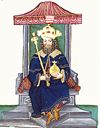 |
Přemyslid | King 1305–1306 | son of Wenceslaus II and Judith of Habsburg Judith of Habsburg Judith of Habsburg was the youngest daughter of Rudolph I of Germany and his wife Gertrude of Hohenburg. Judith was a member of the Habsburg family.-Biography:When Judith was five, she became the object of her father's political plans... uncrowned assassinated |
| Rudolph I of Bohemia Rudolph I of Bohemia Rudolf I of Habsburg was Duke of Austria and Styria from 1298 and King of Bohemia and titular King of Poland from 1306 until his death... (Rudolf Austriacki) |
 |
Habsburg | Titular King of Poland 1306–1307 |
Duke of Austria and Styria (as Rudolph III) |
| Henry of Bohemia (Henryk Karyncki) |
 |
Meinhardin | Titular King of Poland 1307–1310 |
Count of Tyrol and Duke of Carinthia and Carniola (as Henry VI) |
| John of Bohemia (Jan Luksemburski) |
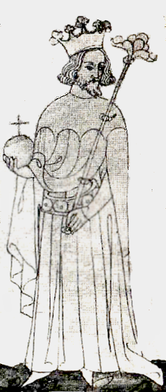 |
Luxembourg House of Luxembourg The House of Luxembourg was a late medieval German dynasty, which between 1308 and 1437 ruled the Holy Roman Empire, twice interrupted by the rivaling House of Wittelsbach.-History:... |
Titular King of Poland 1310–1335 |
Count of Luxembourg (as John the Blind) |
| Ladislas IV/I the Elbow-high (Władysław I Łokietek) |
Piast Piast dynasty The Piast dynasty was the first historical ruling dynasty of Poland. It began with the semi-legendary Piast Kołodziej . The first historical ruler was Duke Mieszko I . The Piasts' royal rule in Poland ended in 1370 with the death of king Casimir the Great... |
High Duke 1306–1320 King 1320–1333 |
restored re-united the Kingdom of Poland |
|
| Casimir III The Great Casimir III of Poland Casimir III the Great , last King of Poland from the Piast dynasty , was the son of King Władysław I the Elbow-high and Hedwig of Kalisz.-Biography:... (Kazimierz III Wielki) |
 |
Piast Piast dynasty The Piast dynasty was the first historical ruling dynasty of Poland. It began with the semi-legendary Piast Kołodziej . The first historical ruler was Duke Mieszko I . The Piasts' royal rule in Poland ended in 1370 with the death of king Casimir the Great... |
King 1333–1370 | son of Ladislas IV/I and Hedwig of Kalisz regarded as one of the greatest Polish monarchs |
| Louis I of Hungary (Ludwik Węgierski) |
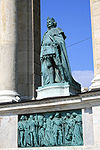 |
Anjou Capetian House of Anjou The Capetian House of Anjou, also known as the House of Anjou-Sicily and House of Anjou-Naples, was a royal house and cadet branch of the direct House of Capet. Founded by Charles I of Sicily, a son of Louis VIII of France, the Capetian king first ruled the Kingdom of Sicily during the 13th century... |
King 1370–1382 | son of Charles I of Hungary Charles I of Hungary Charles I , also known as Charles Robert , was the first King of Hungary and Croatia of the House of Anjou. He was also descended from the old Hungarian Árpád dynasty. His claim to the throne of Hungary was contested by several pretenders... and Elisabeth of Poland nephew of Casimir III elected King and crowned on 17 November also King of Hungary |
| Jadwiga of Poland Jadwiga of Poland Jadwiga was monarch of Poland from 1384 to her death. Her official title was 'king' rather than 'queen', reflecting that she was a sovereign in her own right and not merely a royal consort. She was a member of the Capetian House of Anjou, the daughter of King Louis I of Hungary and Elizabeth of... (Jadwiga Andegaweńska) |
Anjou Capetian House of Anjou The Capetian House of Anjou, also known as the House of Anjou-Sicily and House of Anjou-Naples, was a royal house and cadet branch of the direct House of Capet. Founded by Charles I of Sicily, a son of Louis VIII of France, the Capetian king first ruled the Kingdom of Sicily during the 13th century... |
King 1384–1399 | daughter of Louis I and Elisabeth of Bosnia Elisabeth of Bosnia Elizabeth of Bosnia was Queen of Hungary from 1353 until 1382 and Queen of Poland from 1370 until 1382 as the second wife of King Louis the Great. After her tenure as queen consort, Elizabeth served as regent for her daughter Mary.As queen consort, Elizabeth was overshadowed by her domineering... crowned at 1384 reigned jointly with her husband Ladislas II since 1386 |
|
Jagiellon DynastyJagiellon dynastyThe Jagiellonian dynasty was a royal dynasty originating from the Lithuanian House of Gediminas dynasty that reigned in Central European countries between the 14th and 16th century...
| Ruler | Dynasty | Reign Began | Reign Ended | Notes | |
|---|---|---|---|---|---|
| Władysław II Jagiełło (Ladislas II, Jogaila) |
Jagiellon Jagiellon dynasty The Jagiellonian dynasty was a royal dynasty originating from the Lithuanian House of Gediminas dynasty that reigned in Central European countries between the 14th and 16th century... |
4 March 1386 | 1 June 1434 | son of Algirdas Algirdas Algirdas was a monarch of medieval Lithuania. Algirdas ruled the Grand Duchy of Lithuania from 1345 to 1377, which chiefly meant monarch of Lithuanians and Ruthenians... of Lithuania and Uliana of Tver Grand Duke of Lithuania 1377-1434 reigned jointly with his wife Jadwiga until 1399 the longest reigning king of Poland |
|
| Władysław III Warneńczyk (Ladislas III, Vladislovas III) |
 |
Jagiellon | 25 July 1434 | 10 November 1444 | son of Ladislas II and Sophia of Halshany Sophia of Halshany Sophia of Halshany , was a Lithuanian princess of Halshany, Queen of Poland from , and the last wife of Jogaila.-Biography:... also king of Hungary (as Ulászló I) fell at Varna Battle of Varna The Battle of Varna took place on November 10, 1444 near Varna in eastern Bulgaria. In this battle the Ottoman Empire under Sultan Murad II defeated the Polish and Hungarian armies under Władysław III of Poland and János Hunyadi... , therefore surnamed "of Varna" |
| Kazimierz IV (Casimir IV, Kazimieras Jogailaitis) |
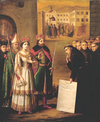 |
Jagiellon | 25 June 1447 | 7 June 1492 | son of Ladislas II and Sophia of Halshany also Grand Duke of Lithuania 1440-1492 |
| Jan I Olbracht (John I Albert, Jonas Albrechtas) |
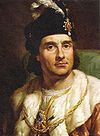 |
Jagiellon | 23 September 1492 | 16 June 1501 | son of Casimir IV and Elisabeth of Austria |
| Aleksander (Alexander, Aleksandras) |
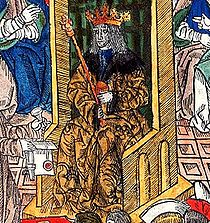 |
Jagiellon | 12 December 1501 | 19 August 1506 | son of Casimir IV and Elisabeth of Austria also Grand Duke of Lithuania 1492-1506 |
| Zygmunt I the Old Sigismund I the Old Sigismund I of Poland , of the Jagiellon dynasty, reigned as King of Poland and also as the Grand Duke of Lithuania from 1506 until 1548... (Sigismund I, Žygimantas Senasis) |
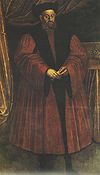 |
Jagiellon | 8 December 1506 | 1 April 1548 | son of Casimir IV and Elisabeth of Austria also Grand Duke of Lithuania forced Prussian Homage Prussian Homage The Prussian Homage or Tribute was the formal investment of Albert of Prussia as duke of the Polish fief of Ducal Prussia.In the aftermath of the armistice ending the Polish-Teutonic War Albert, Grand Master of the Teutonic Knights and a member of the House of Hohenzollern, visited Martin Luther... in 1525 annexed Duchy of Masovia Duchy of Masovia The Duchy of Masovia with its capital at Płock was a medieval duchy formed when the Polish Kingdom of the Piasts fragmented in 1138. It was located in the historic Masovian region of northeastern Poland... in 1526 entered alliance with Maximilian I, Holy Roman Emperor |
| Zygmunt II August I Sigismund II Augustus Sigismund II Augustus I was King of Poland and Grand Duke of Lithuania, the only son of Sigismund I the Old, whom Sigismund II succeeded in 1548... (Sigismund II August I, Žygimantas Augustas) |
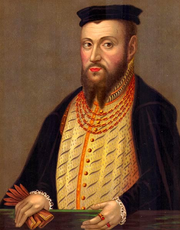 |
Jagiellon | 1 April 1548 | 7 July 1572 | son of Sigismund I and Bona Sforza Bona Sforza Bona Sforza was a member of the powerful Milanese House of Sforza. In 1518, she became the second wife of Sigismund I the Old, the King of Poland and Grand Duke of Lithuania, and became the Queen of Poland and Grand Duchess of Lithuania.She was the third child of Gian Galeazzo Sforza and his wife... also Grand Duke of Lithuania replaced the personal union of the Kingdom of Poland and the Grand Duchy of Lithuania with a real union and an elective monarchy (Polish-Lithuanian Commonwealth Polish-Lithuanian Commonwealth The Polish–Lithuanian Commonwealth was a dualistic state of Poland and Lithuania ruled by a common monarch. It was the largest and one of the most populous countries of 16th- and 17th‑century Europe with some and a multi-ethnic population of 11 million at its peak in the early 17th century... ) in 1569 |
Kings of the Polish-Lithuanian CommonwealthPolish-Lithuanian CommonwealthThe Polish–Lithuanian Commonwealth was a dualistic state of Poland and Lithuania ruled by a common monarch. It was the largest and one of the most populous countries of 16th- and 17th‑century Europe with some and a multi-ethnic population of 11 million at its peak in the early 17th century...
| Ruler | Dynasty | Reign Began | Reign Ended | Notes | |
|---|---|---|---|---|---|
| Henryk Walezy Henry III of France Henry III was King of France from 1574 to 1589. As Henry of Valois, he was the first elected monarch of the Polish-Lithuanian Commonwealth with the dual titles of King of Poland and Grand Duke of Lithuania from 1573 to 1575.-Childhood:Henry was born at the Royal Château de Fontainebleau,... (Henry III) |
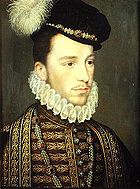 |
Valois Valois Dynasty The House of Valois was a cadet branch of the Capetian dynasty, succeeding the House of Capet as kings of France from 1328 to 1589... |
21 February 1574 | 12 May 1575 | son of Henry II of France Henry II of France Henry II was King of France from 31 March 1547 until his death in 1559.-Early years:Henry was born in the royal Château de Saint-Germain-en-Laye, near Paris, the son of Francis I and Claude, Duchess of Brittany .His father was captured at the Battle of Pavia in 1525 by his sworn enemy,... and Catherine de' Medici Catherine de' Medici Catherine de' Medici was an Italian noblewoman who was Queen consort of France from 1547 until 1559, as the wife of King Henry II of France.... abandoned the Polish-Lithuanian throne three months after his coronation in order to become King of France |
| Maksymilian II Maximilian II, Holy Roman Emperor Maximilian II was king of Bohemia and king of the Romans from 1562, king of Hungary and Croatia from 1563, emperor of the Holy Roman Empire of the German Nation from 1564 until his death... (Maximilian I) |
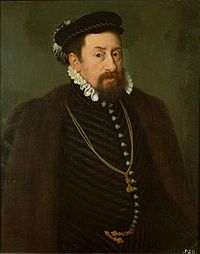 |
Habsburg | 1575 | 1575 | King of Bohemia, Germany, Hungary and Croatia, Archduke of Austria, Holy Roman Emperor Holy Roman Emperor The Holy Roman Emperor is a term used by historians to denote a medieval ruler who, as German King, had also received the title of "Emperor of the Romans" from the Pope... election contested after four days |
| Anna Anna Jagiellon Anna Jagiellon was queen of Poland from 1575 to 1586. She was the daughter of Poland's King Sigismund I the Old, and the wife of Stephen Báthory. She was elected, along with her then fiance, Báthory, as co-ruler in the second election of the Polish-Lithuanian Commonwealth... |
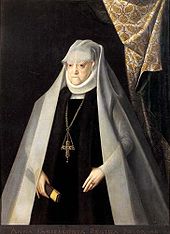 |
Jagiellon Jagiellon dynasty The Jagiellonian dynasty was a royal dynasty originating from the Lithuanian House of Gediminas dynasty that reigned in Central European countries between the 14th and 16th century... |
King 15 December 1575 | 12 December 1586 | daughter of Sigismund I and Bona Sforza reigned together with her husband Stephen Báthory |
| Stefan I Batory (Stephen I Báthory) |
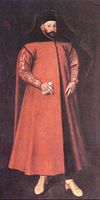 |
Báthory Báthory The Báthory were a Hungarian noble family of the Gutkeled clan. The family rose to significant influence in Central Europe during the late Middle Ages, holding high military, administrative and ecclesiastical positions in the Kingdom of Hungary... |
15 December 1575 | 12 December 1586 | son of Stephen VIII Báthory and Catherine Telegdi Catherine Telegdi Catherine Telegdi was a Hungarian noble lady, the daughter of István Telegdi de Kincstartó and his wife Margit Bebek de Pelsőcz.... Prince of Transylvania reigned together with his wife Anna regarded as one of the greatest kings of Poland |
| Maksymilian III (Maximilian II) |
Habsburg | 1587 | 1587 | son of Maximilian II and Maria of Spain Maria of Spain Archduchess Maria of Austria was the spouse of Maximilian II, Holy Roman Emperor and King of Bohemia and Hungary. She was the daughter of Emperor Charles V and twice served as regent of Spain.-Life:... Archduke of Austria defeated by Zygmunt Vasa |
|
| Zygmunt III Sigismund III Vasa Sigismund III Vasa was King of Poland and Grand Duke of Lithuania, a monarch of the united Polish–Lithuanian Commonwealth from 1587 to 1632, and King of Sweden from 1592 until he was deposed in 1599... (Sigismund III ) |
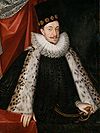 |
Vasa House of Vasa The House of Vasa was the Royal House of Sweden 1523-1654 and of Poland 1587-1668. It originated from a noble family in Uppland of which several members had high offices during the 15th century.... |
18 September 1587 | 19 April 1632 | grandson of Sigismund I son of John III of Sweden John III of Sweden -Family:John married his first wife, Catherine Jagellonica of Poland , house of Jagiello, in Vilnius on 4 October 1562. In Sweden, she is known as Katarina Jagellonica. She was the sister of king Sigismund II Augustus of Poland... and Catherine Jagellon also King of Sweden 1592-1599, titular King 1599-1632 |
| Władysław IV Władysław IV Vasa Władysław IV Vasa was a Polish and Swedish prince from the House of Vasa. He reigned as King of the Polish–Lithuanian Commonwealth from 8 November 1632 to his death in 1648.... (Ladislas IV) |
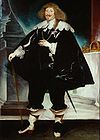 |
Vasa House of Vasa The House of Vasa was the Royal House of Sweden 1523-1654 and of Poland 1587-1668. It originated from a noble family in Uppland of which several members had high offices during the 15th century.... |
8 November 1632 | 20 May 1648 | son of Sigismund III and Anne of Austria Titular Tsar of Russia 1610-1634, titular King of Sweden 1632-1648 |
| Jan II Kazimierz (John II Casimir) |
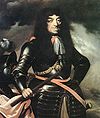 |
Vasa House of Vasa The House of Vasa was the Royal House of Sweden 1523-1654 and of Poland 1587-1668. It originated from a noble family in Uppland of which several members had high offices during the 15th century.... |
20 November 1648 | 16 September 1668 | son of Sigismund III and Constance of Austria Constance of Austria Archduchess Constance of Austria was a Queen consort of Poland.-Biography:... Titular King of Sweden 1648-1660 abdicated |
| Michał Korybut (Michael I) |
Wiśniowiecki | 19 June 1669 | 10 November 1673 | son of a successful but controversial military commander, Jeremi Wiśniowiecki Jeremi Wisniowiecki Jeremi Michał Korybut Wiśniowiecki was a notable member of the aristocracy of the Polish-Lithuanian Commonwealth, Prince at Wiśniowiec, Łubnie and Chorol and a father of future Polish king Michał I... , and Gryzelda Konstancja Zamoyska Gryzelda Konstancja Zamoyska Princess Gryzelda Konstancja Zamoyska was a Polish szlachcianka and mother of King Michał Korybut Wiśniowiecki.... |
|
| Jan III (John III) |
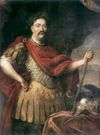 |
Sobieski Sobieski family Sobieski family of Janina coat of arms, also known as House of Sobieski due to their royalty connections, were a notable family of Polish nobility. According to the family's legend, disproved by modern historians, it traced its lineage to Polish duke, Leszek II the Black... |
21 May 1674 | 17 June 1696 | son of Jakub Sobieski Jakub Sobieski Jakub Sobieski was a Polish-Lithuanian noble, parliamentarian, diarist, political activist, military leader and father of King Jan III Sobieski. Son of castellan and voivode Marek Sobieski and Jadwiga Snopkowska.- Life :... and Zofia Teofillia Daniłowicz most famous for his brilliant victory over the Turks at the Battle of Vienna Battle of Vienna The Battle of Vienna took place on 11 and 12 September 1683 after Vienna had been besieged by the Ottoman Empire for two months... in 1683 |
| Franciszek Ludwik Burbon-Conti François Louis, Prince of Conti François Louis de Bourbon, Prince of Conti was Prince de Conti, succeeding his brother Louis Armand I, Prince of Conti in 1685. Until this date he used the title of Prince of La Roche-sur-Yon. He was son of Armand de Bourbon and Anne Marie Martinozzi, niece of Cardinal Jules Mazarin... (François Louis, Prince of Conti) |
 |
Bourbon House of Bourbon The House of Bourbon is a European royal house, a branch of the Capetian dynasty . Bourbon kings first ruled Navarre and France in the 16th century. By the 18th century, members of the Bourbon dynasty also held thrones in Spain, Naples, Sicily, and Parma... |
27 June 1697 | ca. 20 July 1697 (withdrew) | son of Armand de Bourbon-Conti Armand de Bourbon, prince de Conti Armand de Bourbon, Prince de Conti was a French nobleman, the second son of Henry II, Prince of Condé and brother of Louis II de Bourbon, Prince de Condé and Anne Genevieve, Duchess of Longueville. As a member of the reigning House of Bourbon, he was a Prince du Sang.The title of Prince de Conti... and Anne Marie Martinozzi Anne Marie Martinozzi Anne Marie Martinozzi, Princess of Conti was a niece of King Louis XIV of France's chief minister Cardinal Mazarin, and the wife of Armand de Bourbon, Prince of Conti. She became the mother of the libertine François Louis, Prince of Conti, le Grand Conti... elected king, obliged to return to France from Gdansk without the crown |
| August II Mocny Augustus II the Strong Frederick Augustus I or Augustus II the Strong was Elector of Saxony and King of Poland and Grand Duke of Lithuania .... (Augustus II the Strong) |
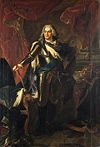 |
Wettin Wettin (dynasty) The House of Wettin is a dynasty of German counts, dukes, prince-electors and kings that once ruled the area of today's German states of Saxony, the Saxon part of Saxony-Anhalt, and Thuringia for more than 800 years... |
15 September 1697 | 16 February 1704 (deposed) 24 September 1706 (abdicates) |
son of John George III John George III, Elector of Saxony Johann Georg III was Elector of Saxony from 1680 to 1691.-Early life:Johann Georg was the only son of the Elector Johann Georg II and Magdalene Sybille of Brandenburg-Bayreuth.... and Anna Sophie of Denmark Anna Sophie of Denmark Princess Anna Sophie of Denmark was the eldest daughter of King Frederick III of Denmark and Sophie Amalie of Brunswick-Lüneburg, and Electress of Saxony from 1680 to 1691 as the wife of John George III.... Elector of Saxony as Frederick Augustus I, 1694–1733 |
| Stanisław I (Stanislas I) |
 |
Leszczyński Leszczynski Leszczyński , plural: Leszczyńscy is the surname of a Polish noble family. Some Polish surnames have different forms for the genders, Leszczyńska is the form for a female family member.-History:... |
4 October 1705 | 8 August 1709 | son of Rafał Leszczyński and Anna Jabłonowska yielded to Augustus II |
| August II Mocny Augustus II the Strong Frederick Augustus I or Augustus II the Strong was Elector of Saxony and King of Poland and Grand Duke of Lithuania .... (Augustus II the Strong) |
 |
Wettin Wettin (dynasty) The House of Wettin is a dynasty of German counts, dukes, prince-electors and kings that once ruled the area of today's German states of Saxony, the Saxon part of Saxony-Anhalt, and Thuringia for more than 800 years... |
8 August 1709 | 1 February 1733 | restored |
| Stanisław I (Stanislas I) |
 |
Leszczyński Leszczynski Leszczyński , plural: Leszczyńscy is the surname of a Polish noble family. Some Polish surnames have different forms for the genders, Leszczyńska is the form for a female family member.-History:... |
12 September 1733 | 30 June 1734 (deposed) 27 January 1736 (abdicates) |
restored defeated in War of the Polish Succession War of the Polish Succession The War of the Polish Succession was a major European war for princes' possessions sparked by a Polish civil war over the succession to Augustus II, King of Poland that other European powers widened in pursuit of their own national interests... became Duke of Lorraine until his death |
| August III Sas Augustus III of Poland Augustus III, known as the Saxon ; ; also Prince-elector Friedrich August II was the Elector of Saxony in 1733-1763, as Frederick Augustus II , King of Poland and Grand Duke of Lithuania in 1734-1763.-Biography:Augustus was the only legitimate son of Augustus II the Strong, Imperial Prince-Elector... (Augustus III) |
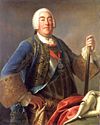 |
Wettin Wettin (dynasty) The House of Wettin is a dynasty of German counts, dukes, prince-electors and kings that once ruled the area of today's German states of Saxony, the Saxon part of Saxony-Anhalt, and Thuringia for more than 800 years... |
17 January 1734 (in opposition) 30 June 1734 (effectively) |
5 October 1763 | son of Augustus II and Christiane Eberhardine of Brandenburg-Bayreuth Christiane Eberhardine of Brandenburg-Bayreuth Christiane Eberhardine of Brandenburg-Bayreuth was Electress of Saxony from 1694 to 1727 and titular Queen of the Polish–Lithuanian Commonwealth from 1697 to 1727 as the wife of Augustus II the Strong. Not once throughout the whole of her thirty-year queenship did she set foot in Poland, instead... |
| Stanisław II August (Stanislas II August) |
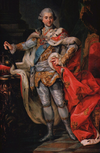 |
Poniatowski Poniatowski Poniatowski is an aristocratic family in Poland. Because Polish adjectives have different forms for the genders, Poniatowska is the same name for a female family member.-History:... |
25 November 1764 | 7 January 1795 | son of Stanisław Poniatowski and Konstancja Czartoryska forced to abdicate when the Polish-Lithuanian Commonwealth (the Polish Republic Polish-Lithuanian Commonwealth The Polish–Lithuanian Commonwealth was a dualistic state of Poland and Lithuania ruled by a common monarch. It was the largest and one of the most populous countries of 16th- and 17th‑century Europe with some and a multi-ethnic population of 11 million at its peak in the early 17th century... since May 3, 1791) ceased to exist |
TsarTsarTsar is a title used to designate certain European Slavic monarchs or supreme rulers. As a system of government in the Tsardom of Russia and Russian Empire, it is known as Tsarist autocracy, or Tsarism...
s of the Tsardom of Poland
| Ruler | Dynasty | Reign Began | Reign Ended | Notes | |
|---|---|---|---|---|---|
| Alexander I Alexander I of Russia Alexander I of Russia , served as Emperor of Russia from 23 March 1801 to 1 December 1825 and the first Russian King of Poland from 1815 to 1825. He was also the first Russian Grand Duke of Finland and Lithuania.... |
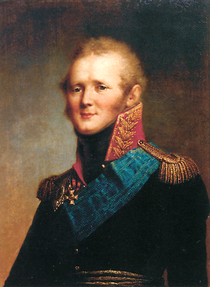 |
Holstein-Gottorp-Romanov | 9 June 1815 | 1 December 1825 | The Kingdom of Poland Congress Poland The Kingdom of Poland , informally known as Congress Poland , created in 1815 by the Congress of Vienna, was a personal union of the Russian parcel of Poland with the Russian Empire... created at the Congress of Vienna Congress of Vienna The Congress of Vienna was a conference of ambassadors of European states chaired by Klemens Wenzel von Metternich, and held in Vienna from September, 1814 to June, 1815. The objective of the Congress was to settle the many issues arising from the French Revolutionary Wars, the Napoleonic Wars,... and therefore dubbed "Congress Poland". |
| Nicholas I Nicholas I of Russia Nicholas I , was the Emperor of Russia from 1825 until 1855, known as one of the most reactionary of the Russian monarchs. On the eve of his death, the Russian Empire reached its historical zenith spanning over 20 million square kilometers... |
 |
Holstein-Gottorp-Romanov | 1 December 1825 | 2 March 1855 | deposed by the Polish Parliament (Sejm Sejm The Sejm is the lower house of the Polish parliament. The Sejm is made up of 460 deputies, or Poseł in Polish . It is elected by universal ballot and is presided over by a speaker called the Marshal of the Sejm .... ) on 25 January 1831 during November Uprising November Uprising The November Uprising , Polish–Russian War 1830–31 also known as the Cadet Revolution, was an armed rebellion in the heartland of partitioned Poland against the Russian Empire. The uprising began on 29 November 1830 in Warsaw when the young Polish officers from the local Army of the Congress... (1830–1831), autonomy abolished in 1832. |
| Alexander II Alexander II of Russia Alexander II , also known as Alexander the Liberator was the Emperor of the Russian Empire from 3 March 1855 until his assassination in 1881... |
 |
Holstein-Gottorp-Romanov | 2 March 1855 | 13 March 1881 | "Congress Poland" annexed into the Russian Empire Russian Empire The Russian Empire was a state that existed from 1721 until the Russian Revolution of 1917. It was the successor to the Tsardom of Russia and the predecessor of the Soviet Union... after January Uprising January Uprising The January Uprising was an uprising in the former Polish-Lithuanian Commonwealth against the Russian Empire... (1863–1864), and the name of the kingdom was changed to Vistula Land Vistula land Vistula Land or Vistula Country was the name applied to the lands of the Kingdom of Poland following the defeats of the November Uprising and January Uprising as it was increasingly stripped of autonomy and incorporated into Imperial Russia... (1867–1915) |
| Alexander III Alexander III of Russia Alexander Alexandrovich Romanov , historically remembered as Alexander III or Alexander the Peacemaker reigned as Emperor of Russia from until his death on .-Disposition:... |
 |
Holstein-Gottorp-Romanov | 13 March 1881 | 1 November 1894 | |
| Nicholas II Nicholas II of Russia Nicholas II was the last Emperor of Russia, Grand Prince of Finland, and titular King of Poland. His official short title was Nicholas II, Emperor and Autocrat of All the Russias and he is known as Saint Nicholas the Passion-Bearer by the Russian Orthodox Church.Nicholas II ruled from 1894 until... |
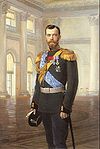 |
Holstein-Gottorp-Romanov | 1 November 1894 | 15 March 1917 | during World War I World War I World War I , which was predominantly called the World War or the Great War from its occurrence until 1939, and the First World War or World War I thereafter, was a major war centred in Europe that began on 28 July 1914 and lasted until 11 November 1918... "Congress Poland" was looted and abandoned by the retreating Russian army Great Retreat (Russian) The Great Retreat was a Russian retreat from Galicia and Poland during World War I.-Background:During this period, the buildup of forces generally favored the Central Powers. Four new German armies, the Eleventh, Twelfth, Army of the Niemen and Army Bug, were being formed up, dramatically shifting... in 1915; abdicated in 1917 |
Kings and Queens of Galicia and LodomeriaKingdom of Galicia and LodomeriaThe Kingdom of Galicia and Lodomeria was a crownland of the Habsburg Monarchy, the Austrian Empire, and Austria–Hungary from 1772 to 1918 .This historical region in eastern Central Europe is currently divided between Poland and Ukraine...
(Galicja)
| Ruler | English | Dynasty | Reign Began | Reign Ended | Notes |
|---|---|---|---|---|---|
| Maria Teresa Maria Theresa of Austria Maria Theresa Walburga Amalia Christina was the only female ruler of the Habsburg dominions and the last of the House of Habsburg. She was the sovereign of Austria, Hungary, Croatia, Bohemia, Mantua, Milan, Lodomeria and Galicia, the Austrian Netherlands and Parma... |
Maria Theresa | Habsburg | 22 September 1772 | 29 November 1780 | the area annexed by the Habsburg Monarchy Habsburg Monarchy The Habsburg Monarchy covered the territories ruled by the junior Austrian branch of the House of Habsburg , and then by the successor House of Habsburg-Lorraine , between 1526 and 1867/1918. The Imperial capital was Vienna, except from 1583 to 1611, when it was moved to Prague... in the First Partition of Poland First Partition of Poland The First Partition of Poland or First Partition of the Polish-Lithuanian Commonwealth took place in 1772 as the first of three partitions that ended the existence of the Polish-Lithuanian Commonwealth by 1795. Growth in the Russian Empire's power, threatening the Kingdom of Prussia and the... (the Polish-Lithuanian Commonwealth); Empress Maria Theresa of Austria (who was also Queen of Hungary, Queen of Bohemia, etc.) recalled the old Hungarian claims to the Regnum Galiciæ et Lodomeriæ, and Czech claims to the Duchies of Auschwitz and Zator |
| Józef II Joseph II, Holy Roman Emperor Joseph II was Holy Roman Emperor from 1765 to 1790 and ruler of the Habsburg lands from 1780 to 1790. He was the eldest son of Empress Maria Theresa and her husband, Francis I... |
Joseph II | Habsburg-Lorraine | 29 November 1780 | 20 February 1790 | |
| Leopold II Leopold II, Holy Roman Emperor Leopold II , born Peter Leopold Joseph Anton Joachim Pius Gotthard, was Holy Roman Emperor and King of Hungary and Bohemia from 1790 to 1792, Archduke of Austria and Grand Duke of Tuscany from 1765 to 1790. He was a son of Emperor Francis I and his wife, Empress Maria Theresa... |
Leopold II | Habsburg-Lorraine | 20 February 1790 | 1 March 1792 | |
| Franciszek II Francis II, Holy Roman Emperor Francis II was the last Holy Roman Emperor, ruling from 1792 until 6 August 1806, when he dissolved the Empire after the disastrous defeat of the Third Coalition by Napoleon at the Battle of Austerlitz... |
Francis II | Habsburg-Lorraine | 1 March 1792 | 2 March 1835 | |
| Ferdynand I Ferdinand I of Austria Ferdinand I was Emperor of Austria, President of the German Confederation, King of Hungary and Bohemia , as well as associated dominions from the death of his father, Francis II, Holy Roman Emperor, until his abdication after the Revolutions of 1848.He married Maria Anna of Savoy, the sixth child... |
Ferdinand I | Habsburg-Lorraine | 2 March 1835 | 2 December 1848 | after the unsuccessful Cracow Uprising Kraków Uprising The Kraków Uprising of February 1846 was an attempt, led by Edward Dembowski, to incite a Polish fight for national independence. Even though most of Poland was part of the Russian Empire, the Polish risings were conducted mainly in Prussia and in the Austrian Empire.-History:Most of the... of 1846, the Free City of Cracow Free City of Kraków The Free, Independent, and Strictly Neutral City of Kraków with its Territory , more commonly known as either the Free City of Kraków or Republic of Kraków , was a city-state created by the Congress of Vienna in 1815, and controlled by its three neighbours until 1846, when in the aftermath of the... was annexed by Austria on 16 November 1846 as the Grand Duchy of Cracow; the full official name of the province was extended to Kingdom of Galicia and Lodomeria, and the Grand Duchy of Cracow with the Duchies of Auschwitz and Zator |
| Franciszek Józef I Franz Joseph I of Austria Franz Joseph I or Francis Joseph I was Emperor of Austria, King of Bohemia, King of Croatia, Apostolic King of Hungary, King of Galicia and Lodomeria and Grand Duke of Cracow from 1848 until his death in 1916.In the December of 1848, Emperor Ferdinand I of Austria abdicated the throne as part of... |
Francis Joseph I | Habsburg-Lorraine | 2 December 1848 | 21 November 1916 | after the Austro-Hungarian Compromise of 1867, and the reorganization of the Empire as the Dual Monarchy Dual monarchy Dual monarchy occurs when two separate kingdoms are ruled by the same monarch, follow the same foreign policy, exist in a customs union with each other and have a combined military but are otherwise self-governing... , a broad autonomy was granted to Galicia and Lodomeria within Cisleithania Cisleithania Cisleithania was a name of the Austrian part of Austria-Hungary, the Dual Monarchy created in 1867 and dissolved in 1918. The name was used by politicians and bureaucrats, but it had no official status... , the Austrian part of Austria-Hungary Austria-Hungary Austria-Hungary , more formally known as the Kingdoms and Lands Represented in the Imperial Council and the Lands of the Holy Hungarian Crown of Saint Stephen, was a constitutional monarchic union between the crowns of the Austrian Empire and the Kingdom of Hungary in... |
| Karol I | Charles I | Habsburg-Lorraine | 21 November 1916 | 11 November 1918 | renounced all participation in affairs of state but did not abdicate |
Dukes of WarsawDuchy of WarsawThe Duchy of Warsaw was a Polish state established by Napoleon I in 1807 from the Polish lands ceded by the Kingdom of Prussia under the terms of the Treaties of Tilsit. The duchy was held in personal union by one of Napoleon's allies, King Frederick Augustus I of Saxony...
(Warszawa)
| Ruler | English | Dynasty | Reign Began | Reign Ended | Notes |
|---|---|---|---|---|---|
| Fryderyk August Frederick Augustus I of Saxony Frederick Augustus I was King of Saxony from the House of Wettin. He was also Elector Frederick Augustus III of Saxony and Duke Frederick Augustus I of Warsaw... |
Frederick August I | Wettin Wettin (dynasty) The House of Wettin is a dynasty of German counts, dukes, prince-electors and kings that once ruled the area of today's German states of Saxony, the Saxon part of Saxony-Anhalt, and Thuringia for more than 800 years... |
9 July 1807 | 14 March 1813 | grandson of Augustus III King of Saxony 1805–1827 Duchy of Warsaw Duchy of Warsaw The Duchy of Warsaw was a Polish state established by Napoleon I in 1807 from the Polish lands ceded by the Kingdom of Prussia under the terms of the Treaties of Tilsit. The duchy was held in personal union by one of Napoleon's allies, King Frederick Augustus I of Saxony... established by Napoleon I Napoleon I Napoleon Bonaparte was a French military and political leader during the latter stages of the French Revolution.As Napoleon I, he was Emperor of the French from 1804 to 1815... in 1807 as a protectorate of the French Empire First French Empire The First French Empire , also known as the Greater French Empire or Napoleonic Empire, was the empire of Napoleon I of France... , dissolved at the Congress of Vienna Congress of Vienna The Congress of Vienna was a conference of ambassadors of European states chaired by Klemens Wenzel von Metternich, and held in Vienna from September, 1814 to June, 1815. The objective of the Congress was to settle the many issues arising from the French Revolutionary Wars, the Napoleonic Wars,... and divided into the Kingdom of Poland Congress Poland The Kingdom of Poland , informally known as Congress Poland , created in 1815 by the Congress of Vienna, was a personal union of the Russian parcel of Poland with the Russian Empire... , protectorate of the Russian Empire Russian Empire The Russian Empire was a state that existed from 1721 until the Russian Revolution of 1917. It was the successor to the Tsardom of Russia and the predecessor of the Soviet Union... , and the Grand Duchy of Posen, protectorate of the Kingdom of Prussia Kingdom of Prussia The Kingdom of Prussia was a German kingdom from 1701 to 1918. Until the defeat of Germany in World War I, it comprised almost two-thirds of the area of the German Empire... |
Grand Dukes of Posen (Poznań)
| Ruler | English | Dynasty | Reign Began | Reign Ended | Notes |
|---|---|---|---|---|---|
| Fryderyk Wilhelm III Frederick William III of Prussia Frederick William III was king of Prussia from 1797 to 1840. He was in personal union the sovereign prince of the Principality of Neuchâtel .-Early life:... |
Frederick William III | Hohenzollern | 9 June 1815 | 7 June 1840 | The Grand Duchy of Posen created at the Congress of Vienna Congress of Vienna The Congress of Vienna was a conference of ambassadors of European states chaired by Klemens Wenzel von Metternich, and held in Vienna from September, 1814 to June, 1815. The objective of the Congress was to settle the many issues arising from the French Revolutionary Wars, the Napoleonic Wars,... ; represented by Duke-Governor Antoni Radziwiłł until 1831. |
| Fryderyk Wilhelm IV Frederick William IV of Prussia |align=right|Upon his accession, he toned down the reactionary policies enacted by his father, easing press censorship and promising to enact a constitution at some point, but he refused to enact a popular legislative assembly, preferring to work with the aristocracy through "united committees" of... |
Frederick William IV | Hohenzollern | 7 June 1840 | 2 January 1861 | autonomy abolished on June 28, 1848; the Grand Duchy was formally replaced by the Province of Posen Province of Posen The Province of Posen was a province of Prussia from 1848–1918 and as such part of the German Empire from 1871 to 1918. The area was about 29,000 km2.... in the Prussian constitution of 5 December 1848. |
| Wilhelm I | William I | Hohenzollern | 2 January 1861 | 9 March 1888 | The Province of Posen, within the Kingdom of Prussia Kingdom of Prussia The Kingdom of Prussia was a German kingdom from 1701 to 1918. Until the defeat of Germany in World War I, it comprised almost two-thirds of the area of the German Empire... , became a part of the German Empire German Empire The German Empire refers to Germany during the "Second Reich" period from the unification of Germany and proclamation of Wilhelm I as German Emperor on 18 January 1871, to 1918, when it became a federal republic after defeat in World War I and the abdication of the Emperor, Wilhelm II.The German... (1871–1918) |
| Fryderyk III Frederick III, German Emperor Frederick III was German Emperor and King of Prussia for 99 days in 1888, the Year of the Three Emperors. Friedrich Wilhelm Nikolaus Karl known informally as Fritz, was the only son of Emperor William I and was raised in his family's tradition of military service... |
Frederick III | Hohenzollern | 9 March 1888 | 15 June 1888 | |
| Wilhelm II | William II | Hohenzollern | 15 June 1888 | 9 November 1918 | abdicated in 1918 |
See also
- Royal coronations in PolandRoyal coronations in PolandRoyal coronations in Poland officially began in 1025 and continued until 1764, when the final King of an independent Poland, Stanisław August Poniatowski, was crowned at St. John's Cathedral in Warsaw. Most Polish coronations took place at the Wawel Cathedral in Kraków, but crownings also occurred...
- Dukes of Greater PolandDukes of Greater PolandThe Duchy of Greater Poland was a historical state of Poland, which existed from 1138 until 1320.-History:At the death of Polish duke Boleslaus III the Wrymouth , according to his testament, his country was divided by his will into 4-5 hereditary provinces distributed among his sons, and the royal...
- Dukes of MasoviaDukes of MasoviaThe Dukes of Masovia were a line of the Piast dynasty who ruled in Masovia. The following is a list of all rulers of the Duchy of Masovia and its parts...
- Dukes of PomeraniaDukes of Pomerania- 10th and 11th century – Dukes of the Slavic Pomeranian tribes :* 1046 mention of Zemuzil * 1113 Gallus Anonymus mentions several dukes of Pomerania: Swantibor, Gniewomir, and an unnamed duke besieged in Kołobrzeg.-Duchy of Pomerania:*1121–1135 Wartislaw I*1135–1155 Ratibor I, ancestor of the...
- Dukes of Sieradz-Łęczyca
- Dukes of SilesiaDukes of SilesiaThe Dukes of Silesia were the sons and descendants of the Polish Duke Bolesław III Wrymouth. In accordance with the last will and testament of Bolesław, upon his death his lands were divided into 4-5 hereditary provinces distributed among his sons, and a royal province of Kraków reserved for the...
- List of Galician rulers
- List of Polish heads of state (1918–present) and list of Prime Ministers of Poland
External links
- Górczyk, Wojciech, "Półksiężyc, orzeł, lew i smok. Uwagi o godłach napieczętnych Piastów" Histmag.org June 14 2009

